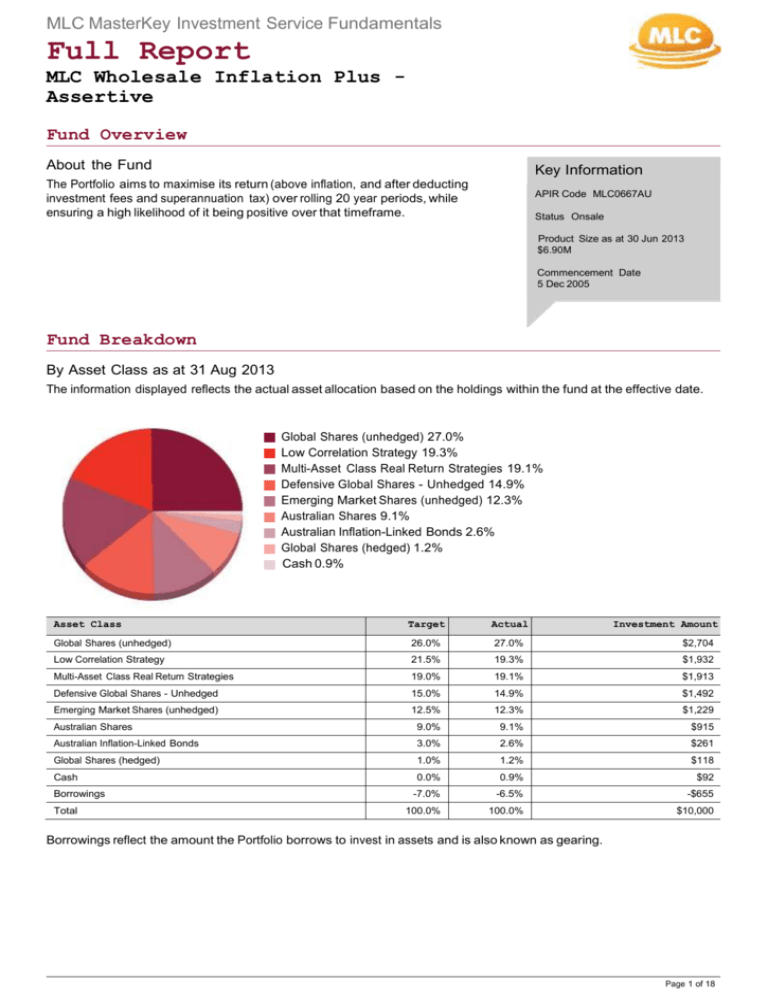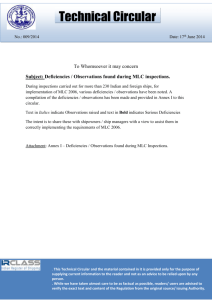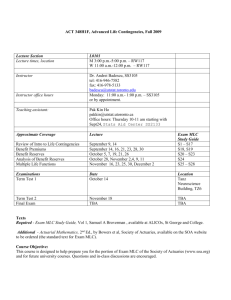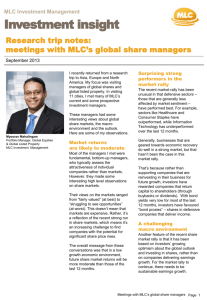
MLC MasterKey Investment Service Fundamentals
Full Report
MLC Wholesale Inflation Plus Assertive
Portfolio
Fund Overview
About the Fund
Key Information
The Portfolio aims to maximise its return (above inflation, and after deducting
investment fees and superannuation tax) over rolling 20 year periods, while
ensuring a high likelihood of it being positive over that timeframe.
APIR Code MLC0667AU
Status Onsale
Product Size as at 30 Jun 2013
$6.90M
Commencement Date
5 Dec 2005
Fund Breakdown
By Asset Class as at 31 Aug 2013
The information displayed reflects the actual asset allocation based on the holdings within the fund at the effective date.
Global Shares (unhedged) 27.0%
Low Correlation Strategy 19.3%
Multi-Asset Class Real Return Strategies 19.1%
Defensive Global Shares - Unhedged 14.9%
Emerging Market Shares (unhedged) 12.3%
Australian Shares 9.1%
Australian Inflation-Linked Bonds 2.6%
Global Shares (hedged) 1.2%
Cash 0.9%
Asset Class
Target
Actual
Investment Amount
Global Shares (unhedged)
26.0%
27.0%
$2,704
Low Correlation Strategy
21.5%
19.3%
$1,932
Multi-Asset Class Real Return Strategies
19.0%
19.1%
$1,913
Defensive Global Shares - Unhedged
15.0%
14.9%
$1,492
Emerging Market Shares (unhedged)
12.5%
12.3%
$1,229
Australian Shares
9.0%
9.1%
$915
Australian Inflation-Linked Bonds
3.0%
2.6%
$261
Global Shares (hedged)
1.0%
1.2%
$118
Cash
Borrowings
Total
0.0%
0.9%
$92
-7.0%
-6.5%
-$655
100.0%
100.0%
$10,000
Borrowings reflect the amount the Portfolio borrows to invest in assets and is also known as gearing.
Page 1 of 18
MLC MasterKey Investment Service Fundamentals
Full Report
MLC Wholesale Inflation Plus Assertive
Portfolio
By Manager as at 31 Aug 2013
Asset Class
Manager
Percentage
Investment Amount
Australian Inflation-Linked Bonds
Antares
2.6%
$261
Australian Shares
Alphinity Investment Management
1.4%
$142
Antares
1.7%
$166
JCP
1.6%
$158
Northcape
1.1%
$114
Vanguard
1.8%
$177
Vinva
1.6%
$158
-6.5%
-$655
0.9%
$92
Borrowings
State Street Brokerage Services
Cash
Cash
Defensive Global Shares - Unhedged
International Value Advisors
14.9%
$1,492
Emerging Market Shares (unhedged)
Capital International
12.3%
$1,229
Global Shares (hedged)
Carnegie Asset Management
0.2%
$16
Dimensional
0.2%
$16
Harding Loevner
0.2%
$18
Sands Capital
0.2%
$16
Walter Scott
0.2%
$18
Carnegie Asset Management
1.7%
$167
Delaware Investment Advisers
1.5%
$150
Dimensional
1.6%
$163
Harding Loevner
1.9%
$190
Mondrian
0.7%
$66
Sands Capital
1.7%
$166
Global Shares (unhedged)
Tweedy, Browne
Walter Scott
Low Correlation Strategy
Nephila
Other
Multi-Asset Class Real Return Strategies
Other
Total
1.5%
$148
16.5%
$1,655
2.5%
$251
16.8%
$1,680
Pyrford
9.6%
$958
Ruffer
9.6%
$955
Other
0.3%
$35
100.0%
$10,000
Borrowings reflect the amount the Portfolio borrows to invest in assets and is also known as gearing.
Page 2 of 18
MLC MasterKey Investment Service Fundamentals
Full Report
MLC Wholesale Inflation Plus Assertive
Portfolio
By Industry as at 31 Aug 2013
Other 41.1%
Financials 10.3%
Information Technology 9.0%
Energy 7.1%
Consumer Discretionary 6.3%
Industrials 6.2%
Industry
Consumer Staples 6.0%
Materials 5.8%
Health Care 4.0%
Telecommunication Services 2.4%
Utilities 0.9%
Real Estate Investment Trusts (REITs) 0.8%
Percentage
Investment Amount
Other
41.1%
$4,106
Financials
10.3%
$1,029
Information Technology
9.0%
$902
Energy
7.1%
$714
Consumer Discretionary
6.3%
$633
Industrials
6.2%
$622
Consumer Staples
6.0%
$604
Materials
5.8%
$580
Health Care
4.0%
$395
Telecommunication Services
2.4%
$243
Utilities
0.9%
$89
Real Estate Investment Trusts (REITs)
Total
0.8%
$83
100.0%
$10,000
Page 3 of 18
MLC MasterKey Investment Service Fundamentals
Full Report
MLC Wholesale Inflation Plus Assertive
Portfolio
By Country as at 31 Aug 2013
North America 30.4%
Australasia 29.9%
Developed Europe (ex U.K.) 11.6%
Developed Asia 10.5%
United Kingdom 9.2%
Emerging Asia 3.6%
Latin America and the Caribbean 3.4%
Emerging Europe 0.9%
Africa/Middle East 0.5%
Country
Percentage
Investment Amount
North America
30.4%
$3,036
Australasia
29.9%
$2,993
Developed Europe (ex U.K.)
11.6%
$1,159
Developed Asia
10.5%
$1,049
United Kingdom
9.2%
$924
Emerging Asia
3.6%
$362
Latin America and the Caribbean
3.4%
$336
Emerging Europe
0.9%
$89
Africa/Middle East
Total
0.5%
$52
100.0%
$10,000
Stock Holdings
Top Stocks for Fund as at 31 Aug 2013
The Top Stocks for Fund have a one month reporting delay.
Stock Description
Industry
Country
Percentage
Investment Amount
BHP BILLITON
Materials
Australia
0.8%
$83
COMMONWEALTH BANK OF AUSTRALIA
Financials
Australia
0.8%
$75
WESTPAC BANKING CORP
Financials
Australia
0.7%
$71
ANZ BANKING GROUP
Financials
Australia
0.6%
$62
GOOGLE INC
Information Technology
USA
0.6%
$56
NATIONAL AUSTRALIA BANK
Financials
Australia
0.5%
$48
NESTLE SA
Consumer Staples
Switzerland
0.5%
$47
SCHLUMBERGER
Energy
Netherlands
0.5%
$46
NIKE INC
Consumer Discretionary
USA
0.4%
$45
MICROSOFT CORP
Information Technology
USA
0.4%
$45
EOG RESOURCES INC
Energy
USA
0.4%
$44
SGS SA
Industrials
Switzerland
0.4%
$44
TELSTRA CORP
Telecommunication Services
Australia
0.4%
$43
MASTERCARD INC
Information Technology
USA
0.4%
$43
NOVO-NORDISK
Health Care
Denmark
0.4%
$43
ADOBE SYSTEMS INC
Information Technology
USA
0.4%
$41
INDITEX GROUP
Consumer Discretionary
Spain
0.4%
$40
PRAXAIR INC
Materials
USA
0.4%
$40
BG GROUP PLC
Energy
United Kingdom
0.4%
$39
SYNGENTA
Materials
Switzerland
0.4%
$39
Page 4 of 18
MLC MasterKey Investment Service Fundamentals
Full Report
MLC Wholesale Inflation Plus Assertive
Portfolio
Top Stocks by Asset Class as at 31 Aug 2013
The Top Stocks by Asset Class have a one month reporting delay.
Australian Shares
Stock Description
Industry
Country
Percentage
Investment Amount
BHP BILLITON
Materials
Australia
0.8%
$83
COMMONWEALTH BANK OF AUSTRALIA
Financials
Australia
0.8%
$75
WESTPAC BANKING CORP
Financials
Australia
0.7%
$71
ANZ BANKING GROUP
Financials
Australia
0.6%
$62
NATIONAL AUSTRALIA BANK
Financials
Australia
0.5%
$48
TELSTRA CORP
Telecommunication Services
Australia
0.4%
$43
WESFARMERS
Consumer Staples
Australia
0.3%
$25
WOOLWORTHS LTD
Consumer Staples
Australia
0.2%
$25
RIO TINTO
Materials
Australia
0.2%
$24
CSL
Health Care
Australia
0.2%
$20
Emerging Market Shares (unhedged)
Stock Description
Industry
Country
Percentage
Investment Amount
STANDARD CHARTERED
Financials
United Kingdom
0.2%
$19
TAIWAN SEMICONDUCTOR
Information Technology
Taiwan
0.2%
$18
ENSCO INTERNATIONAL-SPON ADR
Energy
United Kingdom
0.2%
$16
BHARTI AIRTEL LIMITED
Telecommunication Services
India
0.2%
$16
MEDIATEK INC
Information Technology
Taiwan
0.2%
$16
FIRST QUANTAM MINERALS
Materials
Canada
0.1%
$14
HYUNDAI MOTOR CO
Consumer Discretionary
South Korea
0.1%
$14
FUGRO NV
Energy
Netherlands
0.1%
$12
HKT TRUST AND HKT LTD
Telecommunication Services
Hong Kong
0.1%
$12
BANGKOK BANK
Financials
Thailand
0.1%
$11
Global Shares (hedged)
Stock Description
Industry
Country
Percentage
Investment Amount
GOOGLE INC
Information Technology
USA
0.0%
$3
VISA INC
Information Technology
USA
0.0%
$2
WELLS FARGO
Financials
USA
0.0%
$2
NESTLE SA
Consumer Staples
Switzerland
0.0%
$2
MICROSOFT CORP
Information Technology
USA
0.0%
$1
NIKE INC
Consumer Discretionary
USA
0.0%
$1
SCHLUMBERGER
Energy
Netherlands
0.0%
$1
BRITISH AMERICAN TOBACCO
Consumer Staples
United Kingdom
0.0%
$1
SGS SA
Industrials
Switzerland
0.0%
$1
MASTERCARD INC
Information Technology
USA
0.0%
$1
Page 5 of 18
MLC MasterKey Investment Service Fundamentals
Full Report
MLC Wholesale Inflation Plus Assertive
Portfolio
Global Shares (unhedged)
Stock Description
Industry
Country
Percentage
Investment Amount
GOOGLE INC
Information Technology
USA
0.6%
$56
NESTLE SA
Consumer Staples
Switzerland
0.5%
$47
SCHLUMBERGER
Energy
Netherlands
0.5%
$46
NIKE INC
Consumer Discretionary
USA
0.4%
$45
MICROSOFT CORP
Information Technology
USA
0.4%
$45
EOG RESOURCES INC
Energy
USA
0.4%
$44
SGS SA
Industrials
Switzerland
0.4%
$44
MASTERCARD INC
Information Technology
USA
0.4%
$43
NOVO-NORDISK
Health Care
Denmark
0.4%
$43
ADOBE SYSTEMS INC
Information Technology
USA
0.4%
$41
Performance
Historical Performance
Absolute Fund Returns as at 30 Sep 2013
Returns for periods one year or greater are calculated on an annualised basis. All returns are calculated using end of
month redemption prices assuming all distributions are reinvested and are net of management fees which include
administration fees, issuer fees and investment fees and prior to tax considerations, and do not allow for initial entry fees.
The returns outlined below represent historical performance only and is not an indication of future performance. The value
of an investment may rise or fall with changes in the market. Returns are calculated in accordance with FSC Standard No
6.
Fund Performance
Growth
Distributi
on
3 month
6 month
1 Year
3 Years
5 Years
10 Years
5.7%
12.0%
19.9%
10.4%
8.2%
N/A
Since
Inception
5 Dec 2005
5.4%
5.7%
10.8%
18.6%
6.6%
3.2%
N/A
-1.3%
0.0%
1.2%
1.3%
3.8%
5.1%
N/A
6.7%
Page 6 of 18
MLC MasterKey Investment Service Fundamentals
Full Report
MLC Wholesale Inflation Plus Assertive
Portfolio
Annual Distributions
Period
CPU
2012/2013
0.95
Franking
Level
23.2%
Assessable Income
Non-Assessable Income
81.4
18.6
2011/2012
3.00
7.7%
91.3
8.7
2010/2011
4.22
7.1%
93.2
6.8
2009/2010
7.66
2.9%
98.9
1.1
2008/2009
2.13
14.3%
39.2
60.8
2007/2008
12.21
2.2%
85.5
14.5
2006/2007
8.07
3.6%
53.4
46.6
2005/2006
6.30
6.8%
61.3
38.7
Commentaries
Fund Commentary
As at 30 September 2013
The portfolio returned 4.2% in the quarter and 20.9% in the year to 30 September 2013 (before fees and tax).
Contributors to performance
Key contributors to performance for the quarter and the year are in the following table. Returns are before fees and tax.
For the quarter
Global share markets delivered a strong return over the
quarter despite suffering bouts of weakness as
expectations for monetary policy, particularly in the US,
dominated sentiment.
A large component of the portfolio (30%) is invested in our
defensive global shares (unhedged) strategy which
delivered a strong return of 5.2% over the quarter.
Our more broadly diversified global shares (unhedged)
strategy also produced a strong return of 7.3%. 10% of
the portfolio is currently invested in this strategy.
Our multi-asset real return strategy is 19% of the portfolio,
and produced a positive return of 1.2%
For the year
The portfolios return for the year was strong.
Similar to the quarter, strong returns from defensive global shares
(unhedged) of 28.3% and our more broadly diversified global shares
(unhedged) strategy of 32.5% were key contributors over the year.
The Australian dollars decline this year has meant that unhedged
global shares have significantly outperformed hedged global shares.
This contrasts with the previous few years, when our strong dollar
meant unhedged global shares significantly underperformed
hedged.
The Australian shares strategy finished the year with a strong return
of 25.5%. The last quarter was the highest return for the Australian
share market since 2009. 8% of the portfolio is currently invested in
this strategy.
Page 7 of 18
MLC MasterKey Investment Service Fundamentals
Full Report
MLC Wholesale Inflation Plus Assertive
Portfolio
Our assessment of market conditions
Policy makers are maintaining conditions that support asset prices by suppressing market interest rates. Their aim is to
offset the debt burden through increases in asset values and, hopefully, trigger economic growth. Asset prices have risen
partly on that hope, but also because central banks are almost forcing investors into riskier assets (like shares) by cutting
cash rates and pushing bond yields down. Riskier assets become more attractive as the returns of safer assets decline
and their risk levels increase. While this makes riskier assets look comparatively cheap for the time being, the higher prices
go the less they are supported by fundamentals. Sustaining the share market rally ultimately relies on economic
fundamentals improving.
Tapering of Quantitative Easing is pivotal
The September quarter saw a return to the strong returns from share markets for most of the past year. This followed the
taper-tantrum of the June quarter. After the US Federal Reserves (the Feds) surprise failure to taper Quantitative Easing
(QE) in September, shares rallied and bond yields declined, and emerging markets in particular recovered strongly.
Its unclear whether investors have now become more comfortable with the impact of a gradual QE taper, or whether
there will be renewed jitters when tapering talk starts. Whatever the answer to this, we cant forget the share market
volatility in the June quarter which hinted at the vulnerability that occurs when assets are purchased because they look
cheap compared with government bonds which look very expensive.
The Fed is trying to walk a fine line. In MLCs language, they do not want to see continuation of a high returning Extended
Quantitative Easing (EQE) scenario because it results in excessive risk taking and potentially puts the US back onto an
unstable path. They will be much more comfortable with a muddle-through scenario with modestly higher share prices,
which constitutes a stable adjustment path. Looking forward, there are a number of risks, including the shenanigans over
the debt ceiling, a change of Fed chairman and most importantly, tapering has not gone away: the commencement and
pace of tapering will be pivotal for markets.
Tentative signs of economic growth
To understand what the future might hold, we need to consider the ways in which policy makers actions might or might
not translate into higher growth. We also have to consider whether it might lead to increased inflation, rather than real
economic growth.
While growth is still under pressure in most developed markets, the private sector is showing signs of life in some parts of
the developed global economy, especially the US. The US housing sector and employment seem to be gaining
momentum. Europe, too, is showing very early signs of recovery, but is far behind the US. Each country in the eurozone
has a different level of debt to manage, but they are shackled to a single currency. Those with high debt levels are limited
in their ability to use currency devaluation to reduce the value of their debt. This may hold back a recovery in the region.
Globally, the manufacturing sector is starting to expand. And if the improvements in the US continue, its possible US
consumers and businesses tendencies will move from reducing debt to increasing borrowing. In our scenarios approach
to setting asset allocation, the possibility of US credit growth resuming sooner than expected is covered in our early
re-leveraging scenario. This scenario would help increase trade in countries that rely on exports, like China and other
emerging markets. A pick-up in Europe or Japan would also add to export growth in emerging markets.
Inflation is a watch point
It can be argued that its folly to fight the Fed and that monetary conditions will remain loose, driving risk and asset prices
higher. However, this becomes more uncertain as QE is gradually withdrawn. And there is potential for heightened
instability if an extreme policy stance is reversed. This presents a conundrum: the probability of both a highly positive and
a highly negative scenario may be rising. In this process, inflation remains a watch point.
Todays experimental monetary policy settings could lead to rising inflation: if the supply of something increases massively
its price falls, so if a single country prints money, its exchange rate falls. And if there is collective printing, all currencies are
devalued through inflation. While the Fed has flagged it may reduce quantitative easing if the economy continues to
improve, the potential impact of further quantitative easing on asset prices is still important. Conditions may turn adverse
to growth in the US, and the Bank of Japan and the Bank of England have not been as open as the Fed. With no
roadmap for the withdrawal of policy stimulus, the inflation risks are much bigger than the market currently appreciates.
Portfolio positioning
Key to our investment process is our unique Investment Futures Framework (the new name for our scenarios framework).
In an unpredictable world, the Framework helps us comprehensively assess what the future might hold. By taking into
account the many scenarios that could unfold positive and negative - we gain continuing insight into return potential,
future risks, and opportunities for diversification.
Page 8 of 18
MLC MasterKey Investment Service Fundamentals
Full Report
MLC Wholesale Inflation Plus Assertive
Portfolio
The information from the Framework gives us a deep understanding of how risks and return opportunities change over
time for both individual assets and total portfolios. We can then determine the asset allocations that will help achieve the
portfolios objective with the required level of risk control, and adjust the portfolio if necessary. Well generally reduce
exposure to assets if we believe their high risk isnt matched by a high return. We prefer exposures with limited downside
risk compared to upside potential.
The most challenging environments for our approach occur when prices for a broad range of assets rise faster than their
fundamentals. We faced this dilemma of high prices in the first three quarters of the 2013 financial year and there were
signs of it re-emerging in the September quarter. While growth asset prices rise, their return potential reduces and risk
increases, and this means there are fewer asset classes that provide diversification. With traditional sources of
diversification compromised, we have increased exposure to alternative assets and strategies.
While these trends suggest a more defensive positioning, there remains the real possibility of continued strong returns if
the extended quantitative easing scenario again becomes dominant.
The following table summarises the main positions weve taken in the portfolio.
Position
Impact on performance
Why we have the position
Maintained exposure to
growth assets
We expect returns to lag traditional
diversified funds due to our focus on
reducing the risk of a negative return. Despite
this, we expect returns to meet or exceed
the portfolios objective over its investment
timeframe.
Its possible for global growth to accelerate if the policies implemented
by major central banks are successful and feed through to real
economic growth. Some economic indicators currently suggest that
growth might accelerate in the near term. If the increase in economic
activity is sustained it is possible that we could transition into a
mild-inflationary resolution or early re-leveraging scenario. In these
scenarios, growth assets should perform strongly.
Another scenario that would be positive for growth assets is
extended quantitative easing. This scenario may re-emerge due to
weak economic data. If this happens, the market would push growth
assets higher in anticipation of further monetary stimulus.
Reduced exposure to
interest rate risk by
reducing duration of our
bond strategy
Has limited the negative impact on returns of
rising bond yields over recent months.
In an inflation shock scenario possibly driven by expectations of
inflation nominal bonds would perform poorly and are at risk of
negative returns. Despite low yields, weve maintained some
inflation-linked bond exposure because, unlike nominal bonds,
inflation linked-bond returns increase with rises in inflation.
Reduced exposure to
the Australian dollar
The portfolios large exposure to unhedged
global assets contributed to returns over the
year as the AUD fell.
Although the Australian dollar has declined, it has not fallen far enough
to completely offset the diversification benefit we get from having
some exposure to foreign currency (unhedged assets). This doesnt
mean we expect the AUD to fall further. In two of our scenarios, the
AUD is expected to resume rising. However, as we have many
scenarios where the AUD is expected to fall (eg China slowdown
scenario), and by a greater amount, we prefer foreign currency as a
source of diversification that decreases overall risk. This allows greater
exposure to higher risk asset classes than we would otherwise have
had. If the AUD begins to rise again, it is likely well increase our
exposure to unhedged assets to help offset some of the heightened
risk from high share prices.
Increased allocation to
defensive global shares
Returns from the defensive strategy have
been similar to the strong returns of our other
global share managers over the past year.
In a stagnation or deflationary slump scenario, economic growth in
the developed world would falter. Exposure to defensive global
shares should help reduce exposure to negative returns from a weak
global share market.
Stock selection, too, will likely continue to be an important component of return generation.
Changes to the portfolio
We actively manage our portfolios and work constantly to improve them. In addition to the positions outlined in the table
above, during the quarter we reduced:
borrowings by 6%
the allocation to global shares (unhedged) by 2%,
the allocation to Australian shares by 1%, and
the allocation to the emerging markets strategy (unhedged) by 3%.
Weve been progressively reducing exposure to higher risk assets and borrowings as potential returns from shares have
decreased and risk potential has increased.
Page 9 of 18
MLC MasterKey Investment Service Fundamentals
Full Report
MLC Wholesale Inflation Plus Assertive
Portfolio
Note:
- Please refer to the Market commentary for an overview of what happened in domestic and global markets over the
quarter.
- Fund commentary for this fund will be updated two to three weeks after the end of the month
Market Commentary
As at August 2013
Returns to 31 August 2013
Asset class
1yr (%)
3yr (%)
5yr (%)
10yr (%)
Cash
3.2
4.2
4.3
5.2
Australian bonds
2.3
6.2
7.1
6.2
Global bonds (hedged)
2.8
6.7
8.4
7.7
Australian property securities
16.6
11.3
-0.8
2.9
Global property securities (hedged)
13.0
15.1
5.1
na
Australian shares
24.3
10.1
4.6
9.6
Global shares (hedged)
22.0
15.4
6.1
9.1
Global shares (unhedged)
34.7
12.3
3.7
4.6
Sources: Datastream, MLC Investment Management
Benchmark data are UBS Bank Bill Index (cash), UBS Composite Index (Australian bonds) Barclays Global Aggregate hedged to $A (global bonds),
S&P/ASX200 A-REIT Accumulation Index (Australian property securities), EPRA/NAREIT ($A hedged) (global property securities), S&P/ASX200
Accumulation index (Australian shares) and MSCI All Country Indices hedged and unhedged in $A (global shares).
The outlook for monetary policy particularly expectations about the future behaviour of the US Federal
Reserve (the Fed) has dominated financial market sentiment in recent months. Bond markets around the
world have been unsettled by comments from Fed officials that they may begin tapering the Feds program
of quantitative easing earlier than previously thought. Also contributing to the weakness in bond markets
were some key leading economic indicators from the US that suggest the US economy is steadily
improving. Even in Europe, a number of key indicators suggest the economy is starting to recover.
Higher
bond yields over recent months have resulted in negative returns for investors in both Australian and global
bonds in the last quarter. Over the year to August, bond returns remained positive, but returns have declined.
Share markets also suffered bouts of weakness as investors worried about just how durable the US
economy would prove without the massive support provided by the Fed. The conflict in Syria has added to
market worries, particularly after the use of chemical weapons in late August and then the prospect of a US
military response against the Syrian regime.
Over the quarter, share prices in the developed markets posted slight gains, while share prices in the
emerging economies fell quite sharply. The prospect of the Fed reducing its injections of liquidity into the
financial markets caused share prices and exchange rates in a number of emerging economies to weaken,
particularly in those most dependent on capital inflows.
Australian share market has defied global trends over the last quarter, posting a solid 5.3% return. The
prospect of a clear federal election result contributed to the improvement in market sentiment, as did the
Reserve Bank of Australias decision to again reduce official interest rates in early August, and some better
than expected economic news from China.
Page 10 of 18
MLC MasterKey Investment Service Fundamentals
Full Report
MLC Wholesale Inflation Plus Assertive
Portfolio
Outlook
While the recovery in investment returns over recent years is most welcome, markets have been quite
volatile in recent months. Our view remains that this is a highly uncertain environment for investors, and
one in which managing risk is extremely important. As share markets climbed over the last year, weve
become increasingly concerned that share prices are running too far ahead of the fundamentals in other
words, corporate earnings. This is even though future returns from shares still look very favourable against
those from cash and fixed income.
In bond markets, higher government bond yields have improved the future returns on offer from fixed
income. However, yields are still historically quite low and future returns are likely to be disappointing.
Page 11 of 18
MLC MasterKey Investment Service Fundamentals
Full Report
MLC Wholesale Inflation Plus Assertive
Portfolio
MLC Investment Process
MLC Investment Philosophy
At MLC, we design solutions based on the fundamental need of our investors; to grow and protect wealth for the long
term. To do this we apply our five principles of investing, in our multi-manager portfolios:
The best way to grow wealth is to use excellent investment managers to find the best investments
Extensive research is the only reliable way to identify excellent investment managers and build robust strategies
A long-term approach should be used to achieve long-term financial goals
Sensible diversification reduces risk
Efficient implementation reduces costs and taxes
Portfolio Design
At MLC we put you at the centre of our thinking and focus on what really makes an impact on investor outcomes: asset
allocation. With this in mind, we concentrate on finding the right allocations between asset classes and sub-asset classes
and design portfolios which help investors achieve their financial goals.
Formulating the portfolio
Firstly we consider the objectives of the portfolio and the level of volatility expected. We then look at the different classes
of assets and calculate how we expect them to perform over long periods of time. This helps us to formulate the asset
allocation for the portfolio because longer-term data is far more reliable for predicting the outcomes of asset classes.
To reduce risk we invest in many asset classes because they each perform differently in different circumstances. This
diversification also reduces volatility and leads to smoother returns for the overall portfolio.
Fine tuning the portfolio
We confirm the robustness of the portfolios asset allocation by stress-testing it in around 40 potential economic and
investment environments and against historical market performance data from the last 100 years. This allows us to
develop a clearer picture of how the portfolio will perform in different market conditions and provide investors with
portfolios which have already experienced a range of future outcomes. The process helps us with any fine tuning of the
portfolio to improve the outcome for clients.
Scenario insights and portfolio positioning
Our unique Investment Futures Framework helps us comprehensively assess what the future might hold and how risks
and opportunities may change over time. We use this information to adjust the investment strategy of our portfolios to
manage risk and capture opportunities for returns.
Page 12 of 18
MLC MasterKey Investment Service Fundamentals
Full Report
MLC Wholesale Inflation Plus Assertive
Portfolio
Managing the Managers - Manager Selection
Finding the best businesses to invest in around the world is a specialist skill. We look for investment managers who can
demonstrate a sustainable competitive edge. We also ask our managers to build portfolios that reflect their best ideas.
Our approach to identifying exceptional investment managers involves:
maintaining a clear-cut view on what constitutes an exceptional investment manager e.g. a logical and robust
investment process applied through different market environments; the right people and experience to apply their
process.
meeting regularly with investment managers and individuals in the firm to get a better understanding of how the
investment manager operates, and
analysing the investment managers' portfolios to ensure they are investing the way they say they are.
Specialist managers
Our process typically results in the appointment of managers that specialise in a particular investment style or asset class,
rather than managers who favour an overall approach. The theory behind this is that it's easier to be good at one discipline
than a number of them.
Manager access
Through MLC, our investors can access investment managers who typically only deal with institutional investors. This
gives more access to a wider selection of the best managers in the world, not just those in Australia.
We look at past performance, we dont rely on it
When selecting managers, we look beyond brand and past performance. As markets move in cycles, certain market
conditions will suit different types of managers at different times. This means even the best managers will experience low
performance if market conditions dont suit their approach, and isn't a reason to terminate a manager.
Managing the Managers - Customised Mandates
We typically appoint investment managers who specialise in particular asset classes and investment styles, and assign
each one of them a specific mandate. This approach encourages them to focus on their areas of expertise and build a
portfolio of only their best or highest conviction ideas - companies the managers believe will provide better returns than
other companies and the market overall.
The benefits include:
Higher expected long-term after-tax returns from tailored high conviction portfolios
Insulation from transactions initiated by other investors within a larger investment pool, and
Transaction costs and capital gains tax are reduced both day-to-day and when manager changes occur.
Tax aware investing
Australia has different tax laws to the rest of the world. We select and assign mandates to investment managers we
believe can generate strong-after tax returns over the long term.
Unconstrained approach
We give our global managers the freedom to find the best investments anywhere in the world. This truly global
perspective ensures we make the most of our managers expertise for our investors.
Page 13 of 18
MLC MasterKey Investment Service Fundamentals
Full Report
MLC Wholesale Inflation Plus Assertive
Portfolio
Managing the Managers - Manager Blending
Why blend managers?
We blend managers with different, but complementary, insights into investment markets. This diversification gives
managers the freedom to run with their convictions without having much impact on the overall risk of the portfolio.
And, by selecting only the best managers, who will each peak at different times, long-term returns shouldnt be diluted by
combining several different managers.
Determining each managers allocation
Each asset class strategy we design has a desired risk and return profile. This is used as the basis for determining the
appropriate combination of managers to achieve that profile.
Determining the allocation to each manager starts with our judgement based on intimate knowledge of each managers
investment approach. Data analysis is then used to test the proposed combinations.
Analysing manager portfolios
We use an analytical tool which contains details of every security in each managers portfolio and their characteristics. This
helps us to monitor the managers style and ensures theyre consistent with the strategys objective. We use this
information to confirm the combination of managers who best meet the objectives of the portfolios.
Portfolio Implementation
We have a team of investment professionals dedicated to portfolio implementation. Their key jobs include:
managing daily cash flows to ensure asset allocations and manager weights are kept in balance
managing transitions that result from strategy changes
structuring investment vehicles to facilitate efficient outcomes, and
ensuring the portfolio is implemented in a tax-efficient manner.
Rebalancing and managing cash flows
We apply a disciplined rebalancing approach to keep each portfolio within 2% of its target asset allocation. This means
investors can be confident the original characteristics of the portfolio are retained.
Reducing costs
Implementing changes within the portfolios will result in associated costs. However, our experience in transition
management helps us to keep these costs down so our investors returns are higher.
Ongoing Review
Ongoing research
We actively research asset classes and seek new opportunities to increase returns and reduce risk in our investments.
Manager review activities
We continuously review current and potential managers to ensure we have the best combination to manage our
portfolios.
Manager changes
Just as a sustainable competitive edge is what attracts us to a certain manager, the loss of this edge can lead to a
managers removal. Structural changes to our investment strategy may also lead to changes to the manager line-up.
Page 14 of 18
MLC MasterKey Investment Service Fundamentals
Full Report
MLC Wholesale Inflation Plus Assertive
Portfolio
MLC's Multi-Manager Credentials
A market leader
Weve been providing multi-manager investment portfolios for more than 25 years. Rather than just delivering good returns
over a single period or timeframe, our strategies have consistently delivered strong peer-relative returns on an after-tax
and after-fees basis.
A history of innovation
We continually review and refine our investment solutions. This culture of innovation is driven by our determination to
design investment portfolios which help our investors achieve their financial goals.
Scale
Diversifying across a wide range of some of the worlds best investment managers and implementing the strategy
efficiently takes significant scale and resources. As at 31 March 2010 we had approximately A$50 billion funds under
management making us the largest multi-manager in Australia.
Who uses MLC?
Our investment process is used by some of Australias largest companies and by over one million Australians.
Page 15 of 18
MLC MasterKey Investment Service Fundamentals
Full Report
MLC Wholesale Inflation Plus Assertive
Portfolio
Manager
Profiles
Manages Australian equities for MLC (since November 2012).
Manages AUD$3.1 billion in FUM at 31 December 2012
Based in Sydney, Australia
Manages Australian cash, inflation-linked securities and nominal bonds, since 1991
Stable team of experienced investment professionals
Located in Sydney, Australia
Manages global shares and emerging markets shares for MLC since 1985.
Over 75 years of investment management experience.
Investment offices in 7 countries. Based in Los Angeles, USA.
A total of 46 portfolio managers and 128 research analysts.
Manages Global Shares for MLC, since 2010
Over 20+ years of investment management experience. The philosophy has been unchanged since 1986.
Based in Copenhagen, Denmark
Manages Global Shares for MLC, since 2012
Delaware Investments is based in Philadelphia, Pa.
Managing money at Delaware Investments since April, 2005
The 12-member San Francisco-based Focus Growth Team manages growth equity investments for
Delaware Investments. Within the Delaware Investments equity multi-boutique structure, the investment
teams focus on investing and portfolio management, while enjoying the support of the firm, which provides
shared services such as legal and compliance, distribution, and back-office functions, among others.
Manages two share portfolios for MLC:
Global shares, since 2005
Over 25 years of funds management experience.
Manages global shares for MLC, since 2009
Managed global funds for 20 years
Based in New Jersey, USA
Employs 20 professionals
Manages defensive global shares for MLC (since 2012)
Founded in October 2007, IVA is an investment advisory firm independently owned and managed by five
partners, all of whom worked together previously.
The team is based in New York, USA.
IVA offers a cautious and opportunistic approach to global value investing that has been practised by its
two Portfolio Managers for over forty years combined.
Manages Australian shares for MLC, since 2001
Origins dating back to 1998
50% owned by employees of the firm
Page 16 of 18
MLC MasterKey Investment Service Fundamentals
Full Report
MLC Wholesale Inflation Plus Assertive
Portfolio
Manages global shares for MLC, since 2009
Based in London, UK
Founded in 1990
18 years of stable, consistent leadership
Manages insurance related investments in MLCs low correlation strategy (since 2007)
Origins dating back to 1997
Based in Bermuda, the financial centre of the specialist natural catastrophe reinsurance market.
Manages Australian shares for MLC, since 2005
Based in Sydney, Australia.
Entirely owned by investment team
Manages a multi-asset real return strategy for MLC, since 2012
Based in London, UK
Pyrford has been managing Global Absolute Return assets since 1988
Manages a multi-asset class real return strategy for MLC, since 2009.
Origins dating back to 1994.
Employs 85 professionals.
Based in London, UK
Manages global shares for MLC, since 2009
21-year track record of growth investing
Based in Arlington, Virginia, USA
Manages global shares for MLC, since 2009
Founded in 1920 and serving originally as a broker to Benjamin Graham and other highly noted value
investors, the Firm began managing its first value share portfolio in 1959
Offices in New York and London (research office only). Based in New York, USA
The Firm is managed by five Managing Directors who have worked together between 18-35yrs.
As of 31 December 2008, the current Managing Directors and retired principals and their families, as well
as employees of Tweedy, Browne, had $476 million USD invested in portfolios combined with or similar to
client portfolios.
Manages index based Australian shares for MLC IncomeBuilder, since 2001
The Vanguard Group is the worlds second largest provider of mutual managed funds
Origins dating back to 1929
Manages australian equities for MLC (since 2012)
Established in 2010
Based in Sydney, Australia
An independent boutique investment manager
Page 17 of 18
MLC MasterKey Investment Service Fundamentals
Full Report
MLC Wholesale Inflation Plus Assertive
Portfolio
Manages global shares for MLC, since 2005
Over 25 years of funds management experience
Information in this report does not take into account your objectives, financial situation or needs. Before acting on the information you should consider
whether it is appropriate to your situation. You should consider the relevant Product Disclosure Statement before making a decision about the product.
Past performance is not a reliable indicator of future performance. Please also see Advice Warning and Important Information.
MLC Limited (ABN 90 000 000 402 AFSL 230694) is the issuer of:
MLC MasterKey Investment Bond
MLC Nominees Pty Ltd (ABN 93 002 814 959 AFSL 230702 Trustee of The Universal Super Scheme ABN 44 928 361 101) is the issuer of:
MLC MasterKey Business Super (including MLC MasterKey Personal Super), MLC MasterKey Superannuation, MLC MasterKey Super, MLC MasterKey
Super Fundamentals, MLC MasterKey Allocated Pension, MLC MasterKey Pension, MLC MasterKey Pension Fundamentals, MLC MasterKey Term
Allocated Pension
MLC Investments Limited (ABN 30 002 641 661, AFSL number 230705) is the issuer or operator of:
MLC Investment Trust, MLC MasterKey Investment Service, MLC MasterKey Investment Service Fundamentals, MLC MasterKey Unit Trust, MLC
Investments Limited also trades as MLC Private Investment Consulting.
NULIS Nominees (Australia) Limited (ABN 80 008 515 633 AFSL 236465):
trustee of the MLCS Superannuation Trust ABN 31 919 182 354 is the issuer of Navigator Eligible Rollover Fund ABN 32 649 704 922;
trustee of the MLC Superannuation Fund ABN 40 022 701 955 is the issuer of MLC Wrap Super and MLC Navigator Retirement Plan.
Navigator Australia Limited (ABN 45 006 302 987 AFSL 236466) is the Operator and issuer of:
MLC Wrap Investments, MLC Wrap Self Managed Super and MLC Navigator Investment Plan.
© You are only authorised to use the data and content for the purpose of research, validation and monitoring of your personal investments. You may not
redistribute the data and content to any other person under any circumstances.
2013 Morningstar, Inc. All rights reserved. The data and content contained herein are not guaranteed to be accurate, complete or timely. Neither
Morningstar, nor its affiliates nor their content providers will have any liability for use or distribution of any of this information. To the extent that any of the
content above constitutes advice, it is general advice that has been prepared by Morningstar Australasia Pty Ltd ABN: 95 090 665 544, AFSL: 240892
(a subsidiary of Morningstar, Inc.), without reference to your objectives, financial situation or needs. Before acting on any advice, you should consider the
appropriateness of the advice and we recommend you obtain financial, legal and taxation advice before making any financial investment decision. If
applicable investors should obtain the relevant product disclosure statement and consider it before making any decision to invest. Some material is
copyright and published under licence from ASX Operations Pty Limited ACN 004 523 782 ("ASXO"). DISCLOSURE: Employees may have an interest in
the securities discussed in this report. Please refer to our Financial Services Guide (FSG) for more information at http://www.morningstar.com.au/fsg.asp
Page 18 of 18






